Parameterization of Wave-Induced Mixing Using the Large Eddy Simulation (LES) (I)
Abstract
1. Introduction
2. Experimental Setup
3. Results
3.1. Vertical Velocity, Wavelength and Wave Height
3.2. Wind Speed
3.3. Eddy Viscosity
4. Discussion and Conclusions
- (1)
- The presence of LC could generate stripes of strong vertical velocities to a certain depth, BW could produce small-scale turbulences on the sea surface and could weaken LC near the surface, and LC can influence the mixing to a greater depth than BW. Therefore, it is proposed that the vortex force is a much more effective mechanism in deepening the mixed layer than BW.
- (2)
- It is also identified that as wave heights increase, stripes become more evident. When wavelengths increase, by contrast, vertical velocities are not modified significantly, thus suggesting that the wave-induced mixing is more sensitive to the wave height than to the wavelength.
- (3)
- The Stokes drift velocity and the vertical velocity increase with the wind speed with stripes becoming more evident as well. The influence of LC increases with wind speed.
- (4)
- With increasing depth, the number of stripes declines and stripes become more coherent.
- (5)
- Model results and calculations indicate that LC increases eddy viscosity within the mixed layer, in accordance with previous findings [56]. Additionally, although it is identified that BW could not influence eddy viscosity alone, BW working in tandem with LC leads to reductions in eddy viscosity. The eddy viscosity of polychromatic waves is larger than that of monochromatic waves. Wave-induced mixing could influence the eddy viscosity and enhance the mixing efficiency.
Author Contributions
Funding
Acknowledgments
Conflicts of Interest
References
- Kantha, L.H.; Clayson, C.A. On the effect of surface gravity waves on mixing in the oceanic mixed layer. Ocean. Model 2004, 6, 101–124. [Google Scholar] [CrossRef]
- Craik, A.D.D.; Leibovich, S. A rational model for Langmuir circulations. J. Fluid Mech. 1976, 73, 401–426. [Google Scholar] [CrossRef]
- Leibovich, S. The form and Dynamics of Langmuir Circulations. Ann. Rev. Fluid Mech. 1983, 15, 391–427. [Google Scholar] [CrossRef]
- Smith, J.A. Observations and Theories of Langmuir Circulation: A Story of Mixing Fluid Mechanics and the Environment: Dynamical Approaches; Lumely, J., Ed.; Springer: New York, NY, USA, 2001; pp. 295–314. [Google Scholar]
- Thorpe, S.A. Langmuir circulation. Annu. Rev. Fluid Mech. 2004, 36, 55–79. [Google Scholar] [CrossRef]
- Mcwilliams, J.C.; Sullivan, P.; Moeng, C. Langmuir turbulence in the ocean. J. Fluid Mech. 1997, 334, 1–30. [Google Scholar] [CrossRef]
- Noh, Y.; Min, H.S.; Raasch, S. Large Eddy Simulation of the Ocean Mixed Layer: The Effects of Wave Breaking and Langmuir Circulation. J. Phys. Oceanogr. 2004, 34, 720–735. [Google Scholar] [CrossRef]
- Li, M.; Garrett, C.; Skyllingstad, E. A regime diagram for classifying turbulent large eddies in the upper ocean. Deep-Sea. Res. Pt. I. 2005, 52, 259–278. [Google Scholar] [CrossRef]
- Skyllingstad, E.D. Langmuir Circulation. Marine Turbulence; Baumert, H.Z., Simpson, J.H., Sündermann, J., Eds.; Cambridge University Press: Cambridge, UK, 2005; pp. 277–282. [Google Scholar]
- Harcourt, R.R.; D’Asaro, E.A. Large-eddy simulation of Langmuir turbulence in pure wind seas. J. Phys. Oceanogr. 2008, 38, 1542–1562. [Google Scholar] [CrossRef]
- Grant, A.L.M.; Belcher, S.E. Characteristics of langmuir turbulence in the ocean mixed layer. J. Phys. Oceanogr. 2009, 39, 1871–1887. [Google Scholar] [CrossRef]
- Melville, W.K. The role of surface-wave breaking in air–sea interaction. Annu. Rev. Fluid Mech. 1996, 28, 279–321. [Google Scholar] [CrossRef]
- Terray, E.; Donelan, M.; Agrawal, Y.; Drennan, W.M.; Kahma, K.K.; Williams, A.J.; Hwang, P.A.; Kitaigorodskii, S.A. Estimates of kinetic energy dissipation under breaking waves. J. Phys. Oceanogr. 1996, 26, 792–807. [Google Scholar] [CrossRef]
- Craig, P.D.; Banner, M.L. Modeling wave-enhanced turbulence in the ocean surface layer. J. Phys. Oceanogr. 1994, 24, 2546–2559. [Google Scholar] [CrossRef]
- Mellor, G.L.; Yamada, T. Development of a turbulent closure model for geophysical fluid problems. Rev. Geophys. Space Phys. 1982, 20, 851–875. [Google Scholar] [CrossRef]
- Large, W.G.; McWilliams, J.C.; Doney, S.C. Oceanic vertical mixing: A review and a model with a nonlocal boundary layer parameterization. Rev. Geophys. 1994, 32, 363–403. [Google Scholar] [CrossRef]
- Li, X.; Chao, Y.; Mcwilliams, J.C.; Fu, L.L. A Comparison of Two Vertical-Mixing Schemes in a Pacific Ocean General Circulation Model. J. Clim. 2001, 14, 1377–1398. [Google Scholar] [CrossRef][Green Version]
- Kara, A.B.; Wallcraft, A.J.; Hurlburt, H.E. Climatological SST and MLD Predictions from a Global Layered Ocean Model with an Embedded Mixed Layer. J. Atmos. Ocean. Tech. 2003, 20, 1616–1632. [Google Scholar] [CrossRef]
- Gnanadesikan, A.; Dixon, K.W.; Griffies, S.M. GFDL’s CM2 Global Coupled Climate Models. Part II: The Baseline Ocean Simulation. J. Clim. 2006, 19, 675–697. [Google Scholar] [CrossRef]
- Fox-Kemper, B.; Danabasoglu, G.; Ferrari, R. Parameterization of mixed layer eddies. III: Implementation and impact in global ocean climate simulations. Ocean Model. 2011, 39, 61–78. [Google Scholar] [CrossRef]
- Belcher, E.; Grant, M.; Hanley, E. A global perspective on Langmuir turbulence in the ocean surface boundary layer. Geophys. Res. Lett. 2012, 39, 9. [Google Scholar] [CrossRef]
- Schiller, A.; Ridgway, K.R. Seasonal mixed-layer dynamics in an eddy-resolving ocean circulation model. J. Geophys. Res-Oceans. 2013, 118, 3387–3405. [Google Scholar] [CrossRef]
- Halpern, D.; Chao, Y.; Ma, C.C. Comparison of tropical pacific temperature and current simulations with two vertical mixing schemes embedded in an ocean general circulation model and reference to observations. J. Geophys. Res-Oceans. 1995, 100, 2515–2522. [Google Scholar] [CrossRef]
- Large, W.G.; Danabasoglu, G. Attribution and Impacts of Upper-Ocean Biases in CCSM3. J. Clim. 2006, 19, 2325–2346. [Google Scholar] [CrossRef]
- Tsujino, H.; Hirabara, M.; Nakano, H.; Yasuda, T.; Motoi, T.; Yamanaka, G. Simulating present climate of the global ocean–ice system using the Meteorological Research Institute Community Ocean Model (MRI.COM): Simulation characteristics and variability in the Pacific sector. J. Oceanogr. 2011, 67, 449–479. [Google Scholar] [CrossRef]
- Noh, Y.; Ok, H.; Lee, E.; Toyoda, T.; Hirose, N. Parameterization of Langmuir Circulation in the Ocean Mixed Layer Model Using LES and its Application to the OGCM. J. Phys. Oceanogr. 2015, 46, 57–58. [Google Scholar] [CrossRef]
- Meehl, G.A.; Gent, P.R.; Arblaster, J.M.B.; Otto-Bliesner, L.; Brady, E.C.; Craig, A. Factors that affect the amplitude of El Niño in global coupled climate models. Clim. Dyn. 2001, 17, 515–526. [Google Scholar] [CrossRef]
- Pacanowski, R.C.; Philander, S.G. Parameterization of Vertical Mixing in Numerical Models of the Tropical Oceans. J. Phys. Oceanogr. 1981, 11, 1443–1451. [Google Scholar] [CrossRef]
- Rosati, A.; Miyakoda, K. A General Circulation Model for Upper Ocean Simulation. J. Phys. Oceanogr. 1988, 18, 1601–1626. [Google Scholar] [CrossRef]
- Blanke, B.; Delecluse, P. Variability of the Tropical Atlantic Ocean Simulated by a General Circulation Model with Two Different Mixed-Layer Physics. J. Phys. Oceanogr. 1993, 23, 1363–1388. [Google Scholar] [CrossRef]
- Chen, D.; Rothstein, L.M.; Busalacchi, A.J. A Hybrid Vertical Mixing Scheme and Its Application to Tropical Ocean Models. J. Phys. Oceanogr. 1994, 24, 2156–2179. [Google Scholar] [CrossRef]
- Sterl, A.; Kattenberg, A. Embedding a mixed layer model into an ocean general circulation model of the Atlantic: The importance of surface mixing for heat flux and temperature. J. Geophys. Res-Oceans. 1994, 99, 14139–14157. [Google Scholar] [CrossRef]
- Large, W.G.; Danabasoglu, G.; Doney, S.C.; McWilliams, J.C. Sensitivity to Surface Forcing and Boundary Layer Mixing in a Global Ocean Model: Annual-Mean Climatology. J. Phys. Oceanogr. 1997, 27, 2418–2447. [Google Scholar] [CrossRef]
- Burchard, H.; Bolding, K. Comparative analysis of four second moment turbulence closure models for the ocean mixed layer. J. Phys. Oceanogr. 2001, 31, 1943–1968. [Google Scholar] [CrossRef]
- Noh, Y.; Jang, C.J.; Yamagata, T. Simulation of More Realistic Upper-Ocean Processes from an OGCM with a New Ocean Mixed Layer Model. J. Phys. Oceanogr. 2002, 32, 1284–1307. [Google Scholar] [CrossRef]
- Qiao, F.L.; Yuan, Y.L.; Yang, Y.Z.; Zheng, Q.; Xia, C.; Ma, J. Wave-induced mixing in the upper ocean:Distribution and application in a global ocean circulation model. Geophys. Res. Lett. 2004, 31, L11303. [Google Scholar] [CrossRef]
- Fox-Kemper, B.; Ferrari, R.; Hallberg, R.W. Parameterization of mixed layer eddies. Part I: Theory and diagnosis. J. Phys. Oceanogr. 2008, 38, 1145–1165. [Google Scholar] [CrossRef]
- Richards, K.J.; Xie, S.P.; Miyama, T. Vertical mixing in the ocean and its impact on the coupled ocean/atmosphere system in the Eastern Tropical Pacific. J. Clim. 2009, 22, 3703–3719. [Google Scholar] [CrossRef]
- Sasaki, W.; Richards, K.J.; Luo, J.J. Role of vertical mixing originating from small vertical scale structures within the equatorial thermocline in an OGCM. Ocean Model. 2012, 57, 29–42. [Google Scholar] [CrossRef]
- Li, Y.; Qiao, F.; Yin, X.; Shu, Q.; Ma, H. The improvement of the one-dimensional Mellor-Yamada and K-profile parameterization turbulence schemes with the non-breaking surface wave-induced vertical mixing. Acta Oceanol. Sin. 2013, 32, 62–73. [Google Scholar] [CrossRef]
- Skyllingstad, E.D.; Denbo, D.W. An ocean large-eddy simulation of Langmuir circulations and convection in the surface mixed layer. J. Geophys. Res. 1995, 100, 8501–8522. [Google Scholar] [CrossRef]
- Sullivan, P.P.; Mcwilliams, J.C.; Kendall, M.W. Surface gravity wave effects in the oceanic boundary layer: Large-eddy simulation with vortex force and stochastic breakers. J. Fluid. Mech. 2007, 593, 405–452. [Google Scholar] [CrossRef]
- Mcwilliams, J.C.; Huckle, E.; Liang, J.H.; Sullivan, P.P. The Wavy Ekman Layer: Langmuir Circulations, Breaking Waves, and Reynolds Stress. J. Phy. Oceanogr. 2012, 42, 1793–1816. [Google Scholar] [CrossRef]
- Sullivan, P.P.; Romero, L.; Mcwilliams, J.C.; Melville, W.K. Transient evolution of Langmuir turbulence in ocean boundary layers driven by hurricane winds and waves. J. Phys. Oceanogr. 2012, 42, 1959–1980. [Google Scholar] [CrossRef]
- Skyllingstad, E.D.; Crawford, G.B. Resonant wind-driven mixing in the ocean boundary layer. J. Phys. Oceanogr. 2000, 30, 219–237. [Google Scholar] [CrossRef]
- Sanford, T.B.; Price, J.F.; Girton, J.B.; Webb, D.C. Upper-ocean response to Hurricane Frances (2004) observed by profiling EM-Apex floats. J. Phys. Oceanogr. 2011, 41, 1041–1056. [Google Scholar] [CrossRef]
- Kukulka, T.; Brunner, K. Passive buoyant tracers in the ocean surface boundary layer: 1. Influence of equilibrium wind-waves on vertical distributions. J. Geophys. Res-Oceans. 2015, 120, 3837–3858. [Google Scholar] [CrossRef]
- Brunner, K.; Kukulka, T.; Proskurowski, G. Passive buoyant tracers in the ocean surface boundary layer: 2. Observations and simulations of microplastic marine debris. J. Geophys. Res-Oceans. 2016, 120, 7559–7573. [Google Scholar] [CrossRef]
- Maronga, B.; Gryschka, M.; Heinze, R.; Hoffmann, F.; Kanani-Sühring, F.; Keck, M.; Ketelsen, K.; Letzel, M.O.; Sühring, M.; Raasch, S. The Parallelized Large-Eddy Simulation Model (PALM) version 4.0, for atmospheric and oceanic flows: Model formulation, recent, developments, and future perspectives. Geosci. Model Dev. 2015, 8, 2515–2551. [Google Scholar] [CrossRef]
- Briggs, D.A.; Ferziger, J.H.; Koseff, J.R.; Monismith, S.G. Entrainment in a shear-free turbulent mixing layer. J. Fluid Mech. 1996, 310, 215–241. [Google Scholar] [CrossRef]
- Smith, J.A. Observed growth of Langmuir circulation. J. Geophys. Res-Oceans. 1992, 97, 5651–5664. [Google Scholar] [CrossRef]
- Mcwilliams, J.C.; Restrepo, J.M. The Wave-Driven Ocean Circulation. J. Phy. Oceanogr. 1999, 29, 2523–2540. [Google Scholar] [CrossRef]
- Large, W.G.; Pond, S. Sensible and Latent Heat Flux Measurements over the Ocean. J. Phy. Oceanogr. 1982, 12, 464–482. [Google Scholar] [CrossRef]
- Leibovich, S. Reference Module in Earth Systems and Environmental Sciences. Langmuir Circulation and Instability. Encyclopedia of Ocean Sciences, 3rd ed.; Elsevier: Amsterdam, The Netherlands, 2009; pp. 1453–1461. [Google Scholar]
- Mcwilliams, J.C. Surface wave effects on submesoscale fronts and filaments. J. Fluid Mech. 2018, 843, 479–517. [Google Scholar] [CrossRef]
- Noh, Y.; Goh, G.; Raasch, S.; Gryschka, M. Influence of Langmuir Circulation on the Deepening of the Wind-Mixed Layer. J. Phys. Oceanogr. 2011, 41, 472–484. [Google Scholar] [CrossRef]
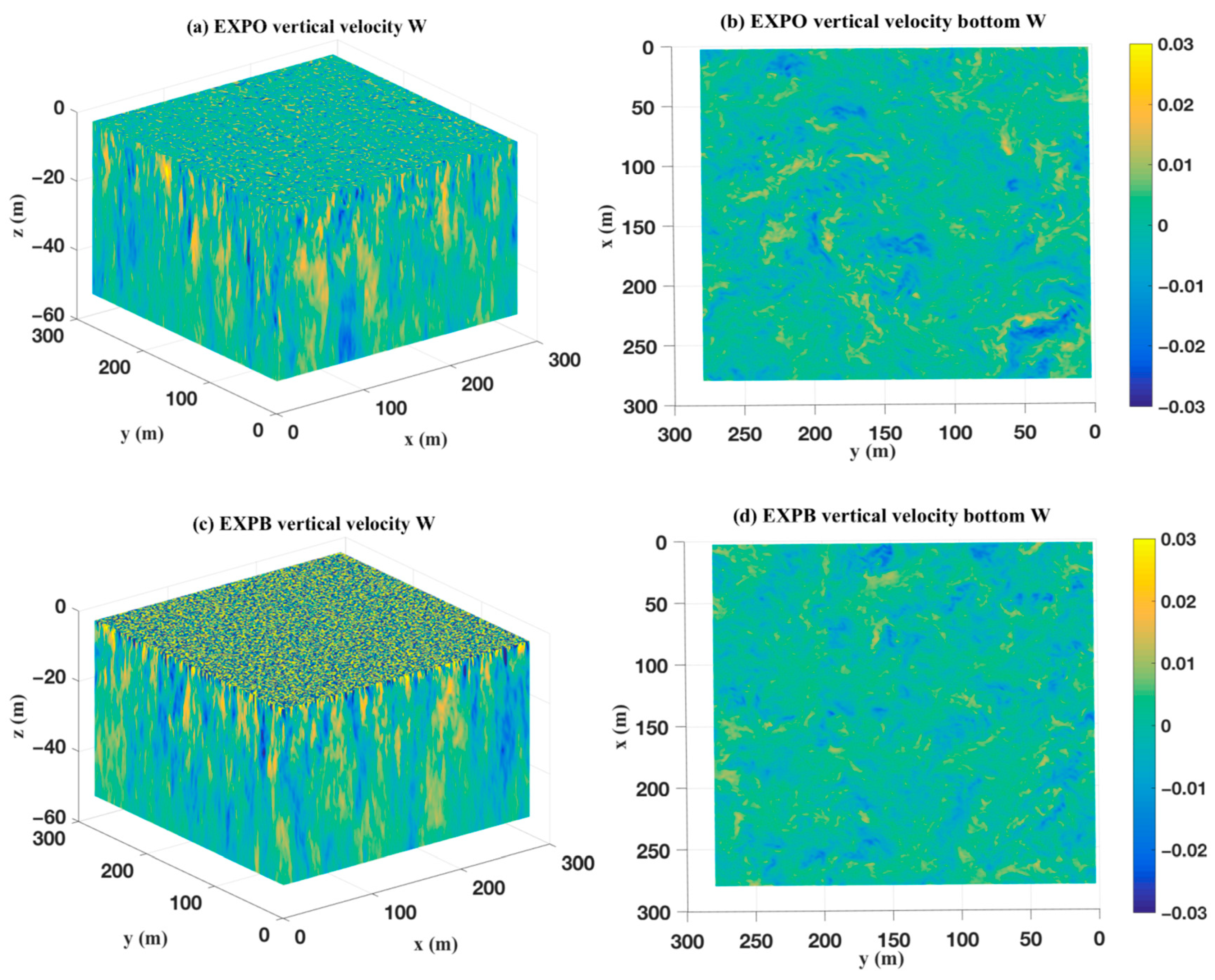
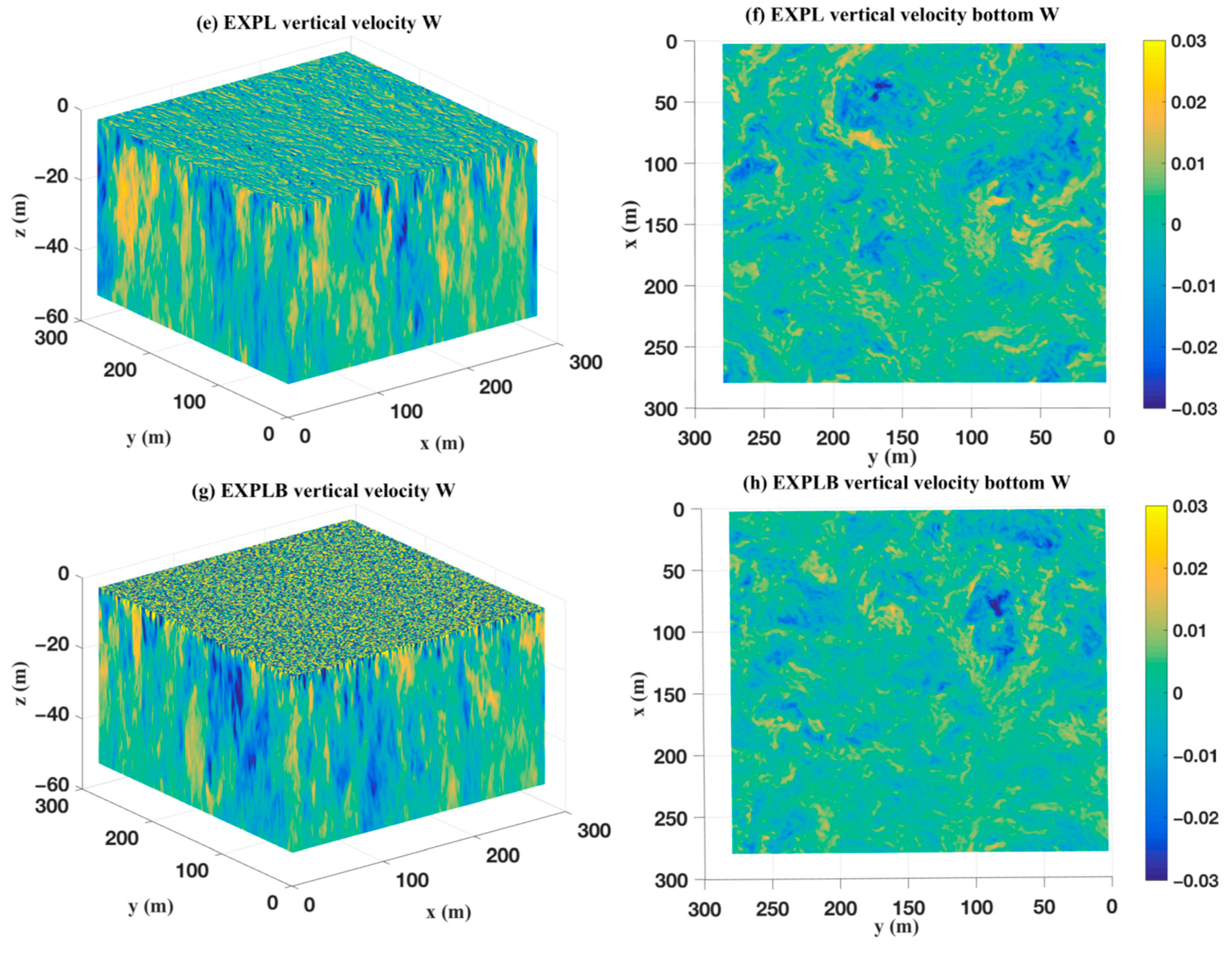
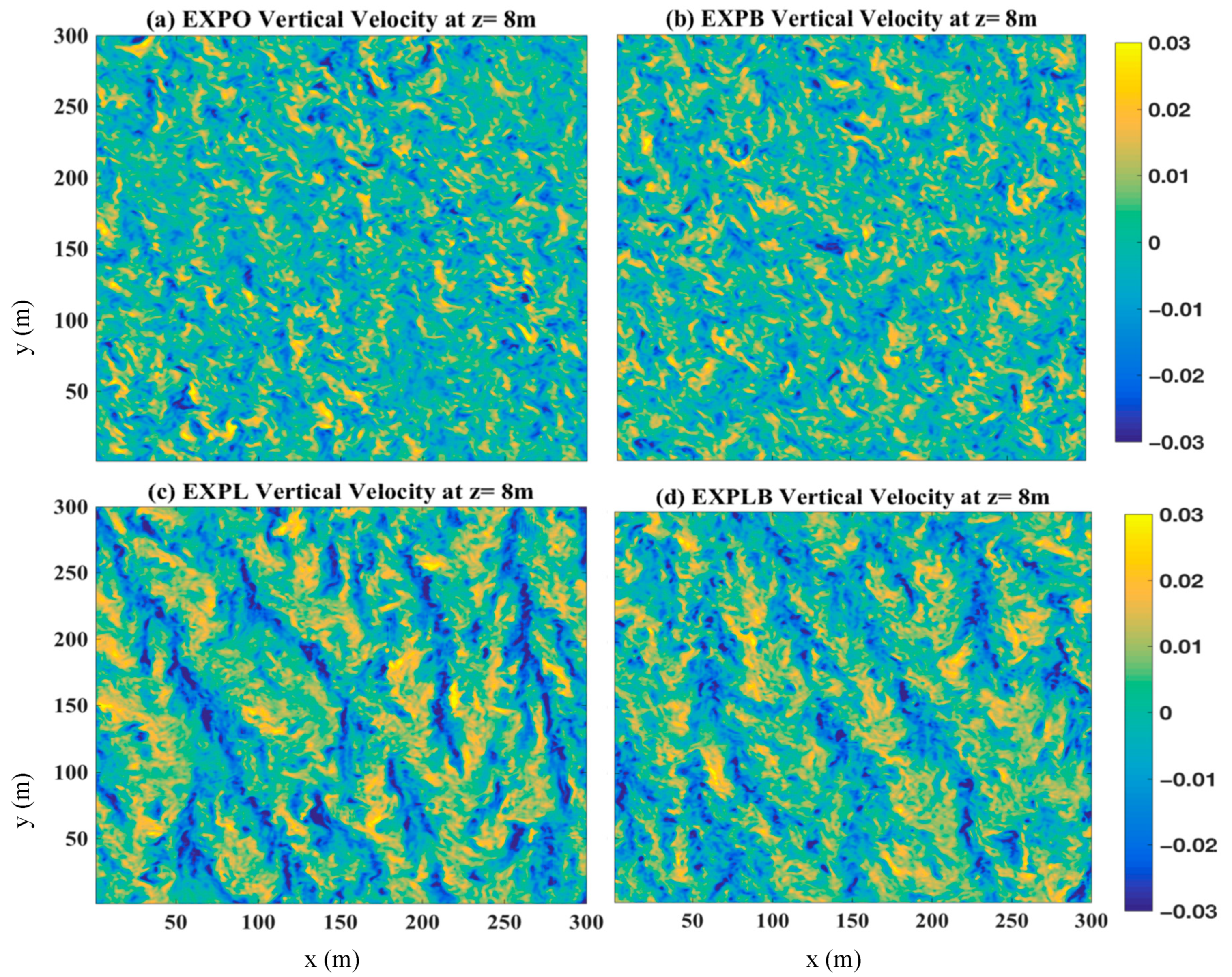
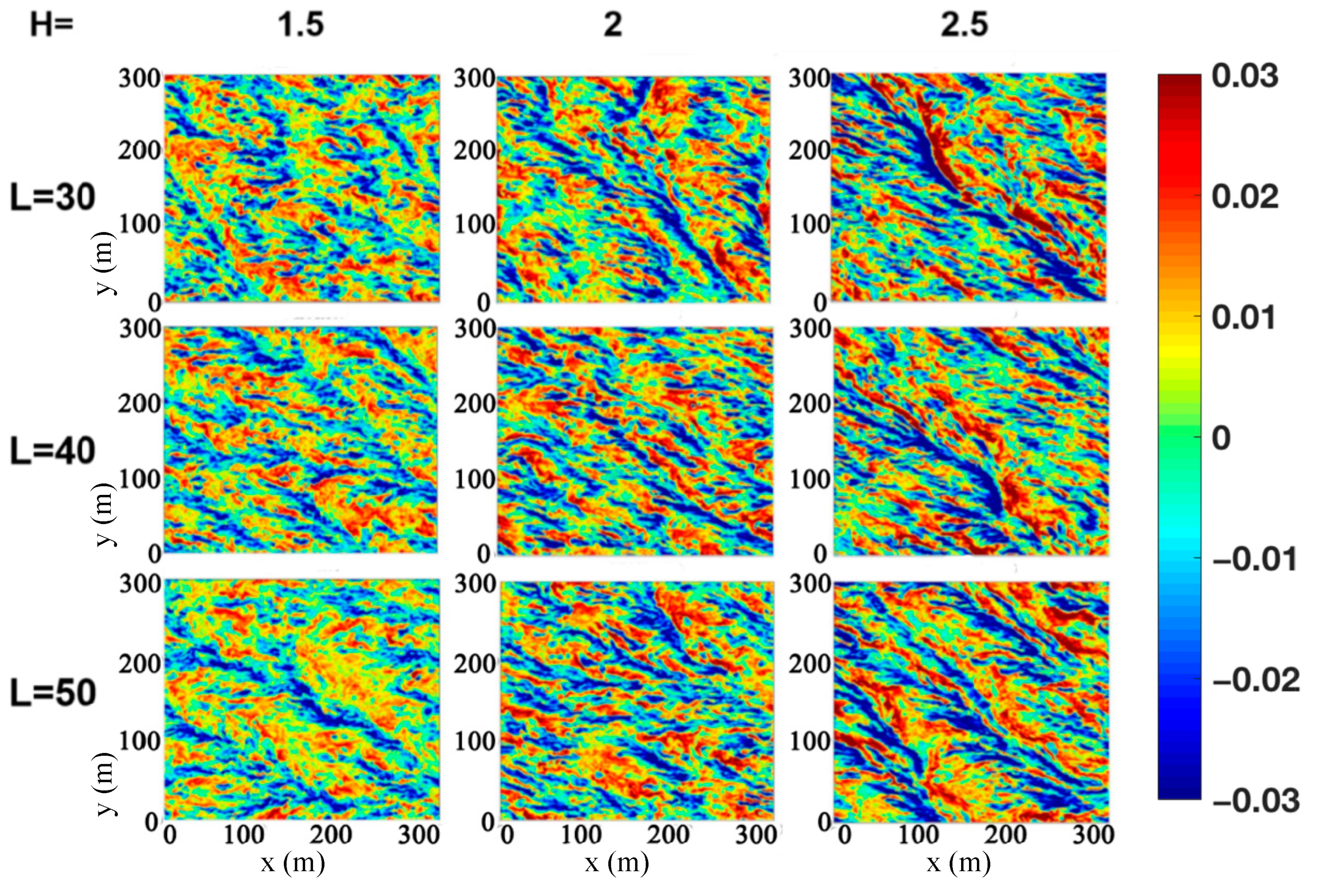
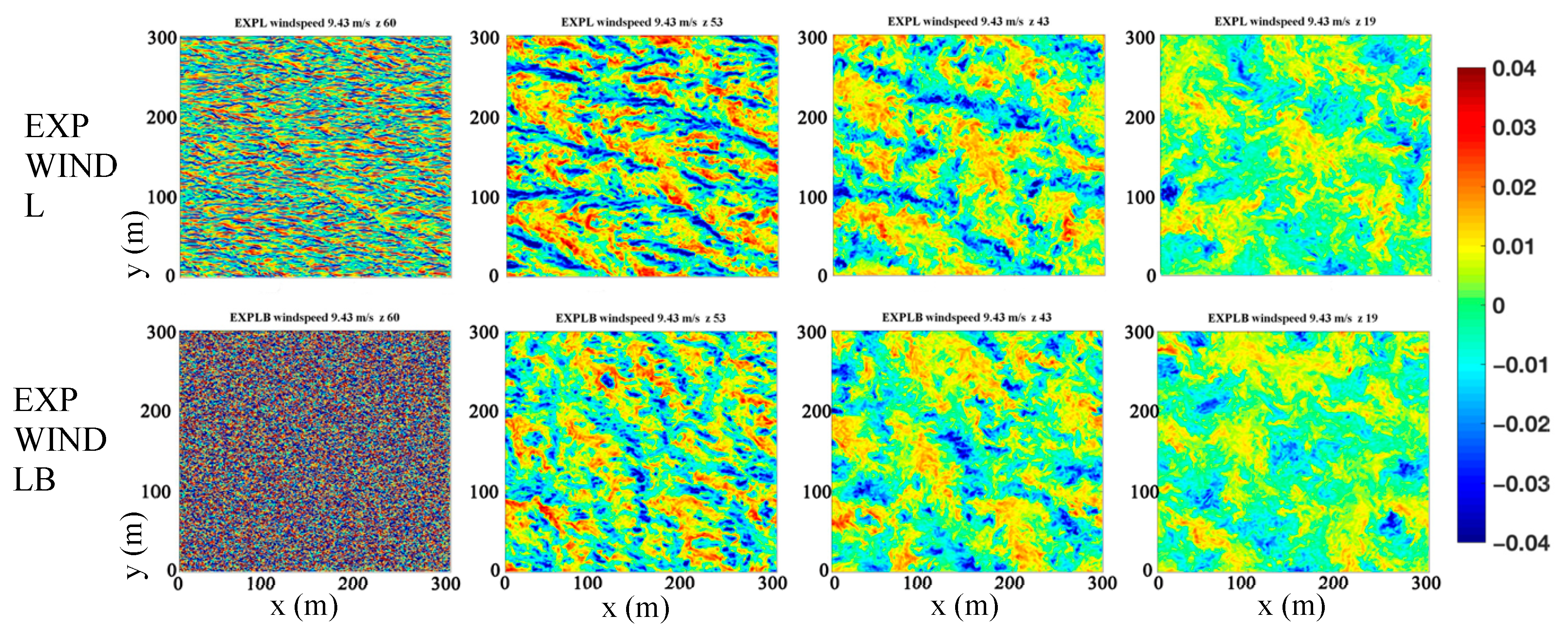
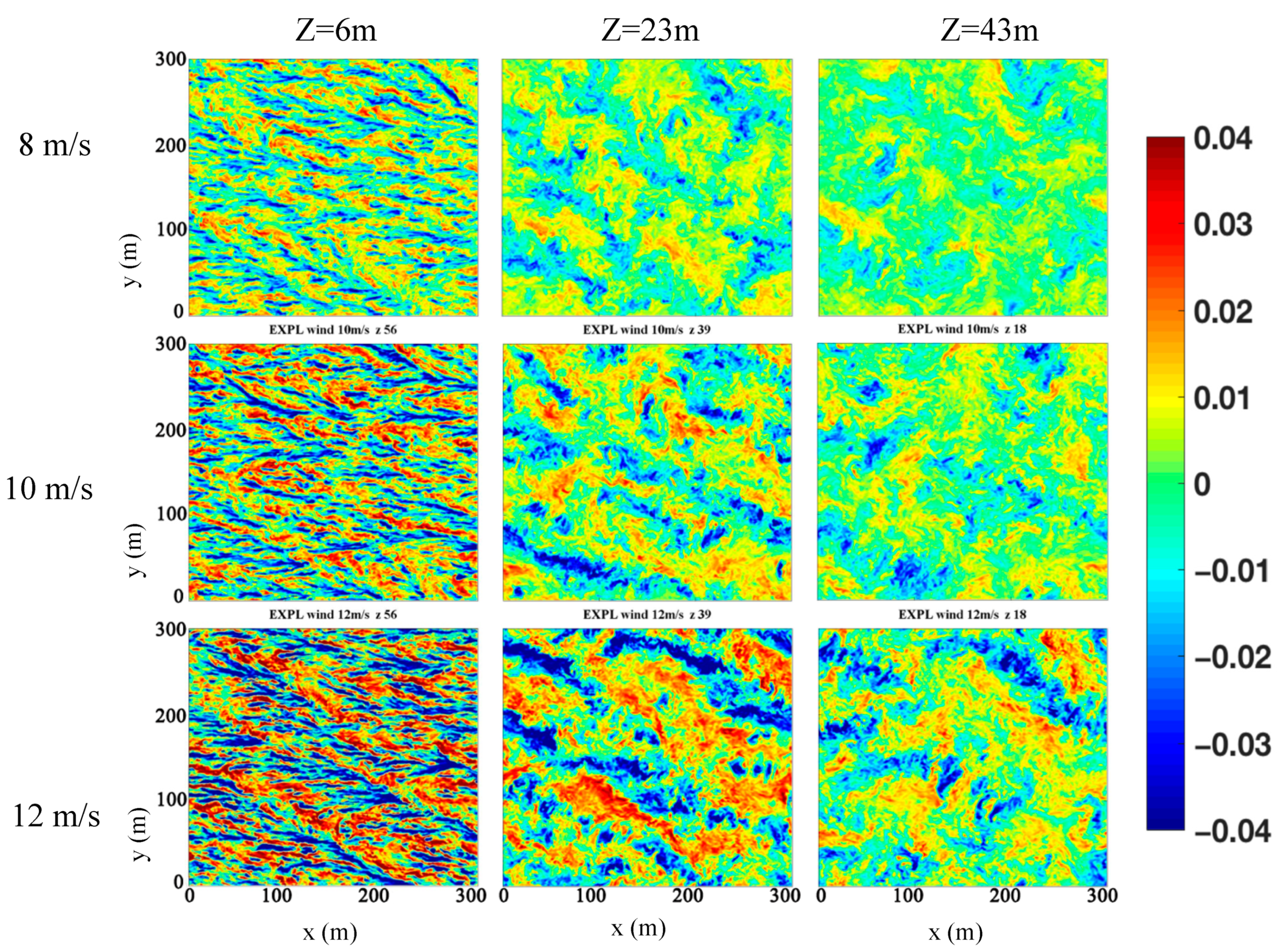
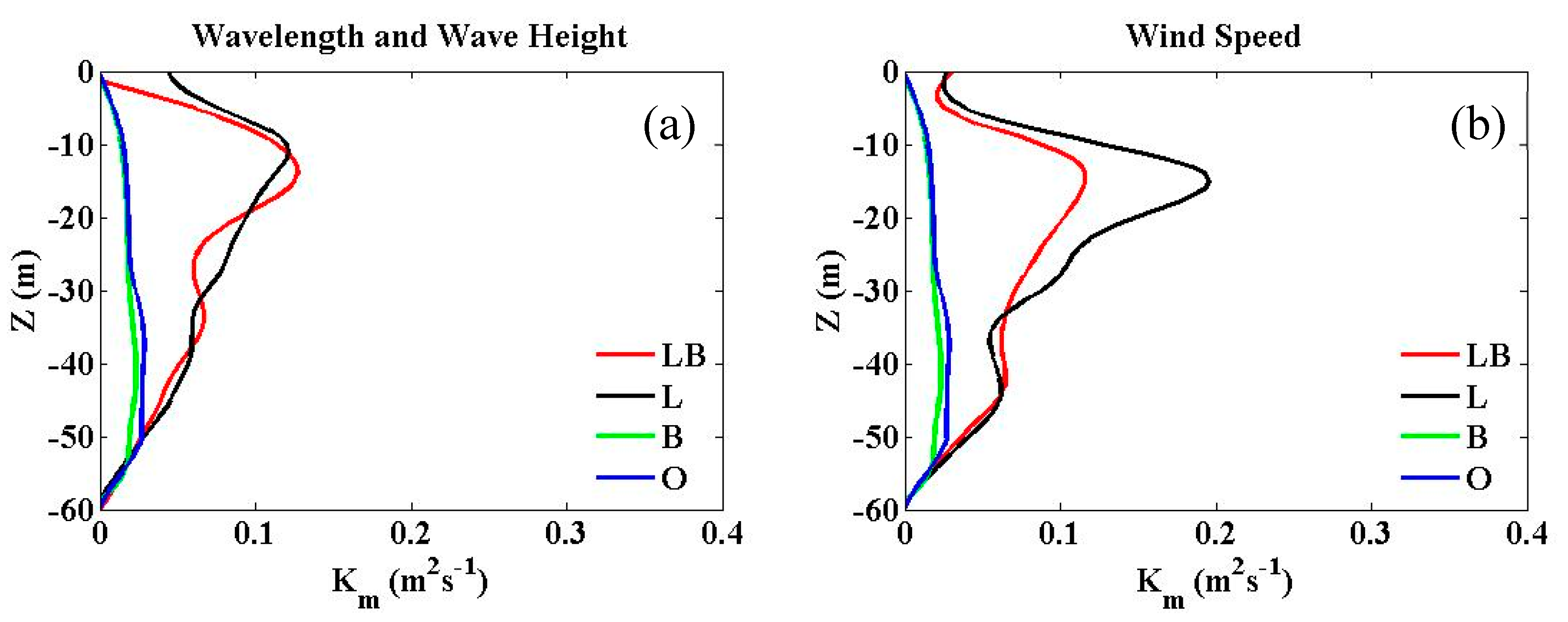
| H | 0.5 | 1 | 1.5 | 2 | 2.5 | 3.0 |
|---|---|---|---|---|---|---|
| λ = 30 | 0.52 | 0.36 | 0.30 | 0.26 | 0.23 | 0.21 |
| λ = 40 | 0.64 | 0.45 | 0.37 | 0.32 | 0.29 | 0.26 |
| λ = 50 | 0.76 | 0.54 | 0.44 | 0.38 | 0.34 | 0.31 |
| U | Lat | |
|---|---|---|
| 0.07 | 8 | 0.16 |
| 0.10 | 9.43 | 0.16 |
| 0.11 | 10 | 0.16 |
| 0.15 | 11 | 0.17 |
| 0.18 | 12 | 0.17 |
| 0.23 | 13 | 0.17 |
| 0.27 | 14 | 0.17 |
| 0.33 | 15 | 0.17 |
| 0.39 | 16 | 0.18 |
© 2020 by the authors. Licensee MDPI, Basel, Switzerland. This article is an open access article distributed under the terms and conditions of the Creative Commons Attribution (CC BY) license (http://creativecommons.org/licenses/by/4.0/).
Share and Cite
Wang, H.; Dong, C.; Yang, Y.; Gao, X. Parameterization of Wave-Induced Mixing Using the Large Eddy Simulation (LES) (I). Atmosphere 2020, 11, 207. https://doi.org/10.3390/atmos11020207
Wang H, Dong C, Yang Y, Gao X. Parameterization of Wave-Induced Mixing Using the Large Eddy Simulation (LES) (I). Atmosphere. 2020; 11(2):207. https://doi.org/10.3390/atmos11020207
Chicago/Turabian StyleWang, Haili, Changming Dong, Yongzeng Yang, and Xiaoqian Gao. 2020. "Parameterization of Wave-Induced Mixing Using the Large Eddy Simulation (LES) (I)" Atmosphere 11, no. 2: 207. https://doi.org/10.3390/atmos11020207
APA StyleWang, H., Dong, C., Yang, Y., & Gao, X. (2020). Parameterization of Wave-Induced Mixing Using the Large Eddy Simulation (LES) (I). Atmosphere, 11(2), 207. https://doi.org/10.3390/atmos11020207






